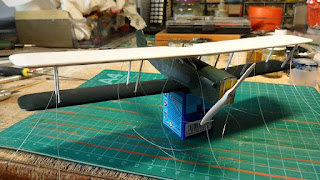A hat tip to Warren for kindly alerting me to this forthcoming surprise release by Arma Hobby of a new Nakajima Ki-84 Hayate kit in the divine scale. Judging by their previous kits it should be a good one and will relegate previous kits in this scale to secondary consideration.
The 'expert set' kit due out in April this year offers Ko or Otsu versions of the fighter with photo-etch and a comprehensive decal sheet with options for a well-chosen variety of schemes and markings. The box art nicely reflects Revell's classic 1966 kit in 104 Sentai guise as painted by Brian Knight, but correctly depicts the yellow trim and wingtips of 2nd Chutai leader Lt Mitsuo Tomiya's Hayate. Other markings options are as follows:-
- Ki-84 '46' of 2 Chutai, 11 Sentai; this is the surviving airframe originally captured in the Philippines. Hayate s/n 1446 was manufactured in December 1944 so should have been in the factory scheme of olive drab, rather than green, over a brownish grey
- Ki-84 '29' of 10 Rensei Hikotai (練成飛行隊 - Training Transformation Air Unit) in unpainted, overall natural metal finish
- Ki-84 '45' of Sakura-tai, 47 Sentai in the factory scheme as flown by Capt Tei-ichi Hatano during the February 1945 air defence sorties against US carrier task force raids
- Ki-84 of 57 Shinbu-tai, one of 15 special attack units organised from within the Akeno Training Air Division in March 1945. It completed training at Shimodate and became operational at the end of May for attacks against US ships off Okinawa
- Ki-84 of 2nd Yuso Hikotai of the Army Transport Unit at Ota, the Nakajima factory airfield; this white tiger adorned Hayate with unusual reticulated 'giraffe' camouflage was flown by Lt Shuho Yamana of that unit from Ota to the Army Air Depot in Saigon towards the end of 1944 for delivery to a combat unit. The unusual reticulated scheme was seen on some Hayabusa and Hien aircraft as well as Hayate. The tiger was painted on the tail freehand by Lt Terai, the commander of the Seibi Shotai maintenance section of the unit, and differed on each side of the tail fin. It signified the Chinese mythology that a tiger could travel a great distance and return within a single day.
Image credit: All © 2022 Arma Hobby











